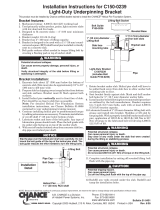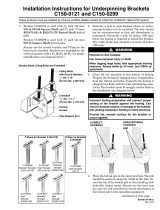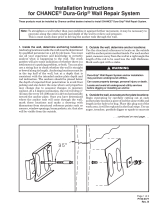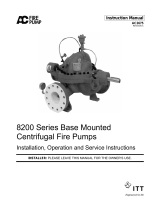Page is loading ...

Potential soil collapse.
Can cause personal injury or death.
When digging large holes, take appropriate shoring
measures.
Always abide by all local and OSHA requirements.
These instructions are intended to illustrate the instal-
lation and use of the Grout and Haunch (GH) Bracket
along with a Type SS Helical Pile. The tools and methods
covered herein should be used by competent personnel
familiar with and following good work and safety prac-
tices. Should additional information and details be de-
sired, or if specific situations arise which are not covered
adequately herein, the user should consult with Chance
Construction, Hubbell Power Systems, Inc.
Please read and understand the entire instruction sheet
before beginning work.
1. Determine where the anchors will be placed and exca-
vate a hole at each location. Place the spoils on tarpau-
lins or boards to help maintain cleanliness in the area
and to speed up backfill after installation. The boards
also may be used to cover holes overnight.
2. The size of the hole required will depend on how deep
the footing is. A wider hole is required if the footing is
more than a few feet below grade. The hole must be wide
enough to expose enough wall or footing (more than 18
inches) for the Grout and Haunch Bracket (GH Bracket).
The hole should be excavated to a depth below the footing
equal to the height of the jack (closed) plus 3 to 4 inches.
3. Prepare the footing by chipping the irregularities from
the bottom side if needed. The bottom surface of the foot-
ing must be flat and smooth in order to have sufficient
bearing area for the lifting jacks and block/shims. Make
sure there is no dirt left on the bottom of the footing.
Rotating crushing hazard.
Can cause property damage, personal injury or death.
Do not position anyone or anything between the
torque bar and the object restraining it. Do not try
to restrain the torque bar by hand. Test the direction
of rotation before beginning by lightly tapping the
hydraulic control valve.
Incorrect footing preparation will not allow the bracket
to seat properly and may result in bracket push out or
rotation.
This can result in damage to the entire structure, the
footing, the bracket, anchor or the jacking equipment.
4. Place the anchor as close to the foundation beam as
possible. The lead helix should be under the foundation
wall. Lift the anchor installer onto the top of the anchor
shaft. Using the pins supplied with the installer, secure it
to the pier shaft.
5. When installing anchors with a hand-held installer, be
sure the torque bar is secured against an immovable ob-
ject. The torque bar will try to rotate opposite the anchor
(counterclockwise if viewed from above) and cannot be
restrained by hand. Lightly tap the hydraulic control
valve to check the direction of rotation of the torque bar
before beginning.
NOTE: Always read and understand the instructions
included with your installation equipment before begin-
ning any installations.
Installation Instructions
for
Grout and Haunch (GH) Bracket
with Helical Piles
▲
! WARNING
▲
! WARNING
▲
! CAUTION
210 North Allen Street, Centralia, MO 65240 USA
Phone: 573-682-8414 Fax: 573-682-8660
Bulletin 01-9619
Rev. 3/07
page 1 of 4
©Copyright 2007 Hubbell Incorporated Printed in USA 500RGSX/07
ISO 9001:2000
Certificate No. 001136
www.abchance.com www.atlassys.com
®
POWER SYSTEMS, INC.
Because Hubbell has a
policy of continuous product
improvement, we reserve the
right to change design and
specications without notice.

Bulletin 01-9619
page 2 of 4
Heical Pile installation may puncture underground
utilities.
Can cause property damage, personal injury or death.
Locate and avoid all underground utility services be-
fore digging or installing an anchor.
6. Apply down pressure on the anchor installer to start
the helix into the ground. Drive the anchor at a 3 to 5
degree angle from vertical (away from the structure). In-
stall the anchor to the predetermined torque correspond-
ing to your particular load requirements. If more depth
is needed, unpin the installer from the shaft. Remove the
installer and add an extension shaft to the existing shaft.
Bolt the two shafts together and then pin the installer to
the extension shaft. Repeat this process as many times as
needed to reach the required torque or depth.
9. Place enough grout around the exposed shaft to cap-
ture all of the GH Bracket baseplate (18" x 8"). The grout
should be a minimum of 2 inches thick. The grout must
be thick enough to touch the underside of the baseplate
when the bracket is placed on the shaft (see Step 10).
NOTE: The grout shall be a 5 sack mix with pea-size
gravel. A quick set additive should be used.
Potential support collapse.
Can cause property damage, personal injury or death.
Do not place shims or spacers of any kind on top of
the anchor shaft. The GH bracket baseplate must set
atop the anchor shaft.
Bending or over-torquing of the anchor or tooling is
hazardous.
Can cause property damage, personal injury or death.
Do not allow visible bending or torque greater than
the rating of the anchor or tooling.
7. Record the installation depth and final torque of in-
stalled anchors for future reference.
8. Terminate the anchor with a flat of the square-shaft
parallel to the grade beam. If necessary, cut the shaft off
at the required height. The shaft should be cut off below
the grade beam. This distance below the grade beam is
equal to the height of the jack (closed) plus 1 inch. Never
use spacers on top of the anchor shaft if the shaft is too
low.
▲
! WARNING ▲
! WARNING
▲
! WARNING

Bulletin 01-9619
page 3 of 4
10. Place the GH Bracket over the anchor shaft. Push
the bracket down until the baseplate settles into the
grout. Be sure that the baseplate comes in contact with
the top of the shaft. The 18-inch length of the baseplate
shall be parallel to the grade beam and level. If the pier
was installed correctly, the baseplate should be cocked at
a 3 to 5 degree angle away from the structure in the di-
rection perpendicular to the grade beam. The top surface
of the baseplate should be free of any grout overflow.
14. Begin lifting or stabilizing the structure by simul-
taneously applying loads to the jacks. Do not exceed the
load rating of the GH Bracket.
11. Allow an appropriate amount of time for the grout
to set up. The grout should be at least the approximate
consistency of stiff clay. Follow the directions and time
recommendations included with the grout or quick set
additive.
12. Place a jack at each end of the baseplate an equal
distance from the centerline of the anchor shaft. The
jacks must be sufficiently spaced to allow a concrete block
to be inserted over the shaft.
NOTE: Always use jacks that have a built in pressure
gage to monitor loads.
13. Place 1⁄2"-thick bearing plates between the top of the
jacks and the bottom of the grade beam. These plates
should be at least 4" x 4".
15. Record the loads achieved for future reference.
16. When the structure is stabilized or lifted to the
desired height, insert a concrete block between the two
jacks. The block must be centered right to left over the
shaft of the anchor. The block must be set far enough un-
der the foundation to obtain sufficient bearing area with
the bottom of the grade beam. See Step 17 for the amount
of final bearing area required.
Potential support collapse.
Can cause property damage, personal injury or death.
Do not exceed the load ratings of the GH Bracket.
WORKING LOAD: 10,000 lb.
ULTIMATE LOAD: 20,000 lb.
NOTE: All concrete blocks shall have a minimum
compressive strength of 3500 psi and a minimum cure
time of 8 days. Blocks of varying dimensions, such as
6" x 8" x 10" are preferred so that height adjustment is
possible.
▲
! WARNING

17. Place steel shims on top of the concrete block to close
the gap between the block and the grade beam. Continue
adding shims until the stack (block and shims) is tight
between the grade beam and the baseplate of the bracket.
Never use more than 2 inches of shims. All shims must
maintain at least 9 square inches of bearing area with
the grade beam and the concrete block.
NOTE: The steel shims shall be a minimum of 4"x 4" in
size. Thicknesses can vary with 1⁄8" and 1⁄4" being the
most common.
▲
Potential support collapse.
Can cause property damage, personal injury or death.
Do not use more than 2 inches of shims. Always
maintain at least 9 square inches of bearing area.
This helps ensure the shims will not slip or kick out.
18. When the shims are properly placed, release the
pressure on the jacks and remove them from the hole.
This will transfer load to the GH Bracket/Helical Pile.
Check to be sure the shims and block remained aligned
and maintained sufficient bearing area.
19. Pack grout all the way around the stack of shims.
The grout should be packed so that it extends out at least
to the edge of the concrete block.
20. Backfill the hole and clean up the area.
TYPICAL INSTALLATION
Bulletin 01-9619
Rev. 3/07
page 4 of 4
quick set concrete
sloped face
of excavation precast
concrete block
existing foundation
Helical Pile shaft
installed at angle
next to foundation
GH Bracket
steel shims,
2" maximum height
! WARNING
/





